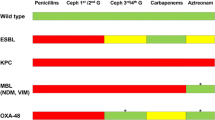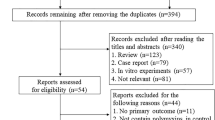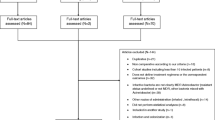Abstract
Carbapenem-resistant Enterobacteriaceae (CRE) are associated with a high mortality rate and are an increasing problem worldwide. In this mini-review, we consider the growing number of observational studies in favour of combination therapy but highlight the absence of randomised control trials. We discuss the importance of data on minimum inhibitory concentrations (MICs), both for surveillance and for individual patient management. We examine the issues surrounding the use of carbapenems, polymyxins and tigecycline in the treatment of CRE. When and how should we be using carbapenems? Which polymyxin is best? Is tigecycline much maligned? Further studies are urgently needed to validate drug combinations, doses and ratios to maximise efficacy whilst reducing drug exposure and adverse effects.
Similar content being viewed by others
References
Tängdén T, Giske CG (2015) Global dissemination of extensively drug-resistant carbapenemase-producing Enterobacteriaceae: clinical perspectives on detection, treatment and infection control. J Intern Med 277(5):501–512
Falagas ME, Tansarli GS, Karageorgopoulos DE, Vardakas KZ (2014) Deaths attributable to carbapenem-resistant Enterobacteriaceae infections. Emerg Infect Dis 20(7):1170–1175
Ben-David D, Kordevani R, Keller N, Tal I, Marzel A, Gal-Mor O et al (2012) Outcome of carbapenem resistant Klebsiella pneumoniae bloodstream infections. Clin Microbiol Infect 18(1):54–60
Zusman O, Avni T, Leibovici L, Adler A, Friberg L, Stergiopoulou T et al (2013) Systematic review and meta-analysis of in vitro synergy of polymyxins and carbapenems. Antimicrob Agents Chemother 57(10):5104–5111
Qureshi ZA, Paterson DL, Potoski BA, Kilayko MC, Sandovsky G, Sordillo E et al (2012) Treatment outcome of bacteremia due to KPC-producing Klebsiella pneumoniae: superiority of combination antimicrobial regimens. Antimicrob Agents Chemother 56(4):2108–2113
Tumbarello M, Viale P, Viscoli C, Trecarichi EM, Tumietto F, Marchese A et al (2012) Predictors of mortality in bloodstream infections caused by Klebsiella pneumoniae carbapenemase-producing K. pneumoniae: importance of combination therapy. Clin Infect Dis 55(7):943–950
Tumbarello M, Trecarichi EM, De Rosa FG, Giannella M, Giacobbe DR, Bassetti M et al (2015) Infections caused by KPC-producing Klebsiella pneumoniae: differences in therapy and mortality in a multicentre study. J Antimicrob Chemother 70(7):2133–2143
Tzouvelekis LS, Markogiannakis A, Piperaki E, Souli M, Daikos GL (2014) Treating infections caused by carbapenemase-producing Enterobacteriaceae. Clin Microbiol Infect 20(9):862–872
Teo J, Lim TP, Hsu LY, Tan TY, Sasikala S, Hon PY et al (2015) Extensively drug-resistant Acinetobacter baumannii in a Thai hospital: a molecular epidemiologic analysis and identification of bactericidal Polymyxin B-based combinations. Antimicrob Resist Infect Control 4(1):2
Safdar N, Handelsman J, Maki DG (2004) Does combination antimicrobial therapy reduce mortality in Gram-negative bacteraemia? A meta-analysis. Lancet Infect Dis 4(8):519–527
Paul M, Lador A, Grozinsky-Glasberg S, Leibovici L (2014) Beta lactam antibiotic monotherapy versus beta lactam-aminoglycoside antibiotic combination therapy for sepsis. Cochrane Database Syst Rev 1:CD003344
Stefani S, Dowzicky MJ (2013) Longitudinal assessment of antimicrobial susceptibility among Gram-negative and Gram-positive organisms collected from Italy as part of the tigecycline evaluation and surveillance trial between 2004 and 2011. Pharmaceuticals (Basel) 6(11):1381–1406
Joly-Guillou ML, Kempf M, Cavallo JD, Chomarat M, Dubreuil L, Maugein J et al (2010) Comparative in vitro activity of Meropenem, Imipenem and Piperacillin/tazobactam against 1071 clinical isolates using 2 different methods: a French multicentre study. BMC Infect Dis 10:72
Craig WA (1998) Pharmacokinetic/pharmacodynamic parameters: rationale for antibacterial dosing of mice and men. Clin Infect Dis 26(1):1–10, quiz 11–2
MacVane SH, Kuti JL, Nicolau DP (2014) Prolonging β-lactam infusion: a review of the rationale and evidence, and guidance for implementation. Int J Antimicrob Agents 43(2):105–113
Kuti JL, Dandekar PK, Nightingale CH, Nicolau DP (2003) Use of Monte Carlo simulation to design an optimized pharmacodynamic dosing strategy for meropenem. J Clin Pharmacol 43(10):1116–1123
Taccone FS, Cotton F, Roisin S, Vincent JL, Jacobs F (2012) Optimal meropenem concentrations to treat multidrug-resistant Pseudomonas aeruginosa septic shock. Antimicrob Agents Chemother 56(4):2129–2131
Bowker KE, Noel AR, Tomaselli SG, Elliott H, Macgowan AP (2012) Pharmacodynamics of the antibacterial effect of and emergence of resistance to doripenem in Pseudomonas aeruginosa and Acinetobacter baumannii in an in vitro pharmacokinetic model. Antimicrob Agents Chemother 56(10):5009–5015
Nation RL, Li J, Cars O, Couet W, Dudley MN, Kaye KS et al (2015) Framework for optimisation of the clinical use of colistin and polymyxin B: the Prato polymyxin consensus. Lancet Infect Dis 15(2):225–234
Nation RL, Velkov T, Li J (2014) Colistin and polymyxin B: peas in a pod, or chalk and cheese? Clin Infect Dis 59(1):88–94
Garonzik SM, Li J, Thamlikitkul V, Paterson DL, Shoham S, Jacob J et al (2011) Population pharmacokinetics of colistin methanesulfonate and formed colistin in critically ill patients from a multicenter study provide dosing suggestions for various categories of patients. Antimicrob Agents Chemother 55(7):3284–3294
Institute for Safe Medication Practices (ISMP) (2011) Warning! Dosing confusion with colistimethate for injection 2011. Cited 15 August 2015
Ni W, Cai X, Wei C, Di X, Cui J, Wang R et al (2015) Efficacy of polymyxins in the treatment of carbapenem-resistant Enterobacteriaceae infections: a systematic review and meta-analysis. Braz J Infect Dis 19(2):170–180
De Rosa FG, Corcione S, Di Perri G, Scaglione F (2015) Re-defining tigecycline therapy. New Microbiol 38(2):121–136
Scaglione F (2011) Comment on: Efficacy and safety of tigecycline: a systematic review and meta-analysis. J Antimicrob Chemother 66(12):2892–2893, author reply 2895–6
Yahav D, Lador A, Paul M, Leibovici L (2011) Efficacy and safety of tigecycline: a systematic review and meta-analysis. J Antimicrob Chemother 66(9):1963–1971
Prasad P, Sun J, Danner RL, Natanson C (2012) Excess deaths associated with tigecycline after approval based on noninferiority trials. Clin Infect Dis 54(12):1699–1709
Cai Y, Wang R, Liang B, Bai N, Liu Y (2011) Systematic review and meta-analysis of the effectiveness and safety of tigecycline for treatment of infectious disease. Antimicrob Agents Chemother 55(3):1162–1172
Tasina E, Haidich AB, Kokkali S, Arvanitidou M (2011) Efficacy and safety of tigecycline for the treatment of infectious diseases: a meta-analysis. Lancet Infect Dis 11(11):834–844
Pournaras S, Vrioni G, Neou E, Dendrinos J, Dimitroulia E, Poulou A et al (2011) Activity of tigecycline alone and in combination with colistin and meropenem against Klebsiella pneumoniae carbapenemase (KPC)-producing Enterobacteriaceae strains by time–kill assay. Int J Antimicrob Agents 37(3):244–247
Sbrana F, Malacarne P, Viaggi B, Costanzo S, Leonetti P, Leonildi A et al (2013) Carbapenem-sparing antibiotic regimens for infections caused by Klebsiella pneumoniae carbapenemase-producing K. pneumoniae in intensive care unit. Clin Infect Dis 56(5):697–700
Bulik CC, Nicolau DP (2011) Double-carbapenem therapy for carbapenemase-producing Klebsiella pneumoniae. Antimicrob Agents Chemother 55(6):3002–3004
Chua NG, Zhou YP, Tan TT, Lingegowda PB, Lee W, Lim TP et al (2015) Polymyxin B with dual carbapenem combination therapy against carbapenemase-producing Klebsiella pneumoniae. J Infect 70(3):309–311
Giamarellou H, Galani L, Baziaka F, Karaiskos I (2013) Effectiveness of a double-carbapenem regimen for infections in humans due to carbapenemase-producing pandrug-resistant Klebsiella pneumoniae. Antimicrob Agents Chemother 57(5):2388–2390
Conflict of interest
The authors declare that they have no conflict of interest.
Author information
Authors and Affiliations
Corresponding author
Rights and permissions
About this article
Cite this article
Nabarro, L.E.B., Veeraraghavan, B. Combination therapy for carbapenem-resistant Enterobacteriaceae: increasing evidence, unanswered questions, potential solutions. Eur J Clin Microbiol Infect Dis 34, 2307–2311 (2015). https://doi.org/10.1007/s10096-015-2486-7
Received:
Accepted:
Published:
Issue Date:
DOI: https://doi.org/10.1007/s10096-015-2486-7




